

Do We Know Any More About the Future of Cities Than We Did in April 2020? - Blogs. Bloomberg - Are you a robot? Debating the Future of Cities After the Coronavirus, Volume 3 - Blogs. Maybe density and congestion weren't the factors for predicting the changes the novel coronavirus would bring to cities and communities.
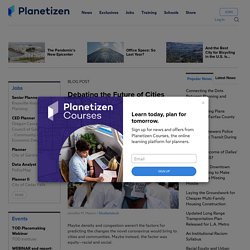
Maybe instead, the factor was equity—racial and social. It was always predictable that the most vulnerable populations would suffer the most economic distress during the pandemic. Maybe in hindsight, it should have been easily, tragically predictable that the worst public health outcomes of the pandemic would be felt in Black and Latino communities. Maybe in hindsight it should have been predictable that by the third month of this tragic public health crisis, the public urban planning discussion would be almost completely focused on reckoning with institutional, structural, and systemic racism.
Pedestrian & Bicycle Information Center. COVID-19 Resources and Community Tracking for Walking and Bicycling Source: Pedestrian and Bicycle Information Center How are communities and the organizations that support them responding to COVID-19 impacts on walking and biking?
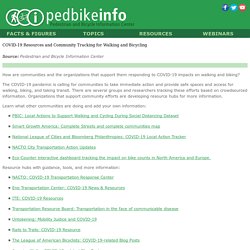
The COVID-19 pandemic is calling for communities to take immediate action and provide safe spaces and access for walking, biking, and taking transit. There are several groups and researchers tracking these efforts based on crowdsourced information. Organizations that support community efforts are developing resource hubs for more information. Learn what other communities are doing and add your own information: About - Reimagining the Civic Commons - Reimagining the Civic Commons. We believe in the power of the civic commons to deliver social, economic and environmental benefits.
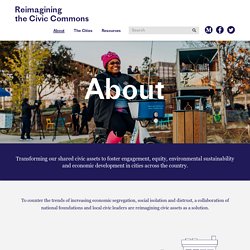
These four outcomes guide this new approach to public space: Civic Engagement Building a sense of community that brings people of all backgrounds back into public life as stewards and advocates, shaping their city’s future.Signals: Public life, stewardship and advocacy, trust. Socioeconomic Mixing Creating places where everyone belongs, and that generate opportunities for shared experience among people of all incomes and backgrounds.Signals: Mixing on site, reputation, bridging social capital, neighborhood diversity. Macon - Reimagining the Civic Commons - Reimagining the Civic Commons. As with many cities, in the 20th century, roads and highways became the main planning and economic development tools for Macon, resulting in blighted and disconnected neighborhoods and a struggling downtown.

Macon is looking to reverse this trend by focusing on connecting all residents to the assets that sprawl left behind: a walkable downtown and beautiful inner core homes and buildings. While downtown has seen a renaissance of housing and small businesses, its public spaces are still lacking. Macon will focus its efforts on investing in a network of trails that will connect disinvested neighborhoods to downtown while expanding economic opportunity to more people. A Necessary Paradigm Shift in How We Use Urban Space. As some cities and communities start to gradually lift their COVID-19 shelter-in-place orders and open up again, we are clearly moving into a transition phase between the emergency response and a future “new normal” until a cure or vaccine is developed for this disease.
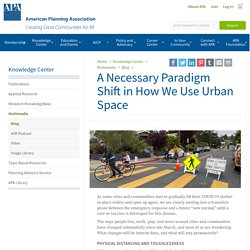
The ways people live, work, play, and move around cities and communities have changed substantially since late March, and most of us are wondering: What changes will be interim fixes, and what will stay permanently? Physical Distancing and Touchlessness If there is one thing we have all learned during this pandemic, it’s that our cities are not built for physical distancing and shelter in place.
(I say “physical” instead of “social” distancing because, in times like these, social connections are more important than ever before.) Most of the public space we can find in U.S. cities is dedicated to cars, not people. The lack of parks and green space in cities should not be news to us. Turning Streets into Living Rooms. NACTO Releases Pandemic Streets Design Guide - News. How Life in Cities Will Change Due to the Coronavirus Pandemic.
Cities are at the center of this pandemic, as they have been during so many plagues in history.
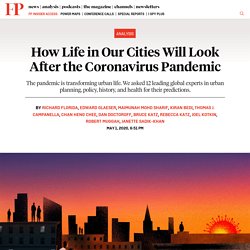
The virus originated in a crowded city in central China. It spread between cities and has taken the most lives in cities. New York has become the world’s saddest, most dismal viral hotspot. Hunkered down at home, rarely venturing into hauntingly empty streets, most of us are still at a loss at how urban life will look afterwards. Will restaurants survive and jobs come back? Bill Gates: The next outbreak? We're not ready. COVID-19 Resources. The novel coronavirus (COVID-19) pandemic is having a significant impact on communities, and planners are on the front lines of response and recovery.

APA is committed to providing resources, information, and tools to address your immediate needs and help you prepare for what is to come. Learn more about how we are using the practice of foresight to "learn with the future," prepare for uncertainty, and navigate this disruptive change. Turn to APA for trusted, timely and useful resources, updated frequently. Planning Methods and Tools. Open Letter to Citymakers: 10 Key Implications of the COVID-19 - NewCities. On January 21st, I traveled from Shanghai, my adopted home, via a one-day layover in Los Angeles, on my way to spend several weeks in Boston for some non-critical medical treatments.
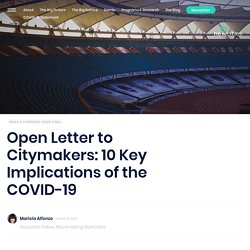
The next day, the first case of Coronavirus hit Shanghai. Four days later, my husband, who owns an import-export business joined me in the Boston burbs, where we’ve been in a sort of pandemic exile since. As the virus spread through Wuhan, Shanghai, and the rest of China, we followed the news incessantly and got daily updates from our Shanghai friends about how this then-epidemic was taking hold of our beloved city. Publications - Know Your City - SDI. Will COVID-19 Make Us Think of Cities Differently? - NewCities. SARS-CoV-2, or ‘COVID-19’, is quite a formidable foe.
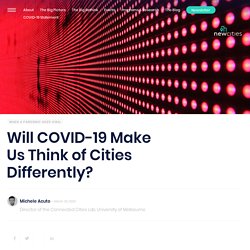
Easily transmissible, low-mortality rate, the flu-like virus spread across national borders and social strata with little discrimination. Cities and urban thinking might be fundamentally affected by the present reality of quarantine, social distancing, and global dis-connection. Will all of this drive a change in the way we plan and govern cities? The crisis did not come without warning.
SARS and H5N1 (2003), H1N1 (2009), MERS (2012), Ebola (2014), Zika (2016), all regularly reminded us of the eventuality we are now living. Don’t Waste A Crisis (Part One) - NewCities. This article was originally published on the Fondation pour l’innovation politique’s website on April 3rd 2020.
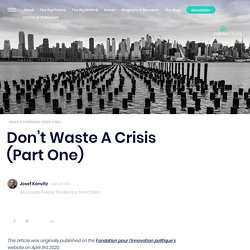
When there is great suffering and uncertainty, people are conflicted between a desire to return to normality (which, after all, is familiar) and a desire to redeem the loss of life and wealth that accompanies a meta-catastrophe by making things better. Both responses are rational and understandable, and probably most of us do not want to choose one over the other. The problem is to find a workable balance. Let me make this less abstract. What impact will the investment in infrastructure that will surely follow the COVID-19 pandemic have on the future of cities? - The Washington Post.
Lessons Emerge as Cities Cede Public Space to Contain the Pandemic - Features. During and after the first weekend of stay-at-home orders in the nation's largest cities, officials scrambled to shut down parks and public open spaces after crowding quickly made social distancing guidelines impossible. Planetizen gathered the relevant news on March 24, mostly focusing on the cities taking the earliest, drastic actions to slow the spread of the coronavirus—like New York City and Los Angeles. Since then, parks all over the country have been closed after visitors quickly overwhelmed social distancing guidelines while seeking refuge from the anxieties of the pandemic. Think pieces about what the pandemic means for the collective appreciation for parks and open space are also common. A New Appreciation for Parks and Open Space When the pandemic is finally over, there will be a lot of aspects of contemporary life to appreciate again, with new perspective on their value to the social and economic well being of communities.
Debating the Future of Cities, and Urban Density, After the Pandemic - Blogs. Cities after coronavirus: how Covid-19 could radically alter urban life. Victoria Embankment, which runs for a mile and a quarter along the River Thames, is many people’s idea of quintessential London. Some of the earliest postcards sent in Britain depicted its broad promenades and resplendent gardens. The Metropolitan Board of Works, which oversaw its construction, hailed it as an “appropriate, and appropriately civilised, cityscape for a prosperous commercial society”.
But the embankment, now hardwired into our urban consciousness, is entirely the product of pandemic. Without a series of devastating global cholera outbreaks in the 19th century – including one in London in the early 1850s that claimed more than 10,000 lives – the need for a new, modern sewerage system may never have been identified. Coronavirus: How cities can adapt to Covid-19. The Covid-19 pandemic is presenting difficulties to everyone in the US right now, but some of the biggest challenges are being faced by cities. Normally hives of social and economic activity, cities have been forced to shut down almost completely. Even in shutdown, though, people still need to remain active. Cities still need usable spaces that can accommodate physical distancing. Meeting those needs presents an incredibly urgent and disconcertingly novel set of problems for city officials. To talk through the ways that cities might rise to meet these challenges, and what things cities ought to be doing that they aren’t doing yet, I turned to long-time urbanist Brent Toderian, previously the chief planner for Vancouver, British Columbia, now a consultant and speaker.
In 2017, he and I had a long, five-part conversation about urbanism in the 21st century. We spoke on April 10; our conversation has been edited for length and clarity. David Roberts Brent Toderian David Roberts Yes and no. How Will COVID-19 Affect Urban Planning? How the COVID-19 pandemic will change our cities. More flexible public transit Nothing drives change in cities more than transportation technology. Throughout history, advances in transportation technology — trolleys, trains, cars, freeways — have allowed cities to expand and made it possible for people and activities to connect in new ways. Much of the left-right debate about urban transportation boils down, unfortunately, to cars versus buses and trains. In particular, right-wing commentators have begun pushing the argument that COVID-19 means the death of public transit.
But this argument overlooks two important realities: First, in a city, it’s simply impossible to transport everybody by themselves in a car. And second, technology is about to blow past the car-transit dichotomy. Mostly, this is just math about space: The average sitting human being consumes about 6 square feet. Just as a one-person Ford F-150 isn’t the right solution for everybody, neither is a 40-person bus or a 90-person light-rail car, even in a city.
What a Coronavirus Recovery Could Look Like. What We Know About Density and Covid-19's Spread. How Coronavirus Is Reshaping City Streets. The fight against coronavirus has brought cities to a standstill. With roughly one third of the global population under lockdown, vehicle traffic has all but vanished on the world’s busiest roads and highways. Public transit ridership in global metros has dropped by more than 80% since early January. For residents in one U.S. city, Seattle, the average daily travel distance has gone from the length of the Las Vegas Strip to that of a bowling alley. But essential workers — doctors, nurses, grocers, pharmacists, delivery drivers, and others — are still commuting, and homebound folks must still make trips for survival goods. Now local governments are taking action to help that critical movement happen more easily: They’re striping new bike lanes, retooling traffic signals, suspending transit fares, closing some streets to vehicle traffic, and taking other temporary transportation measures.
Maybe when this is all over we can widen the sidewalks. — Dan Rather (@DanRather) April 2, 2020. How Will the Pandemic Transform Urban Space? The harrowing reach of Covid-19 has prompted a surge in big urban thinking. How the Coronavirus Could Change City Planning.